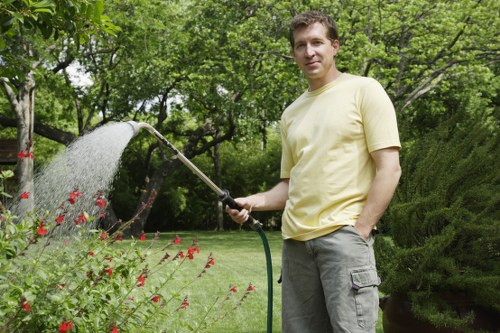Landscaping Canary Wharf: Transforming London's Financial Hub

Canary Wharf, renowned as one of London's premier financial districts, is not just a hub for business but also a showcase of stunning landscaping. The blend of modern architecture with lush greenery creates an environment that is both aesthetically pleasing and functionally beneficial.
Effective landscaping in Canary Wharf enhances the area's appeal, providing office workers and visitors with serene spaces to relax and unwind amidst the bustling city.
From meticulously designed green spaces to innovative sustainable practices, the landscaping efforts in Canary Wharf set a benchmark for urban environments.
The Importance of Landscaping in Urban Areas
Urban landscaping plays a crucial role in enhancing the quality of life in densely populated areas like Canary Wharf. It contributes to environmental sustainability, improves air quality, and offers recreational spaces for the community.
Green areas mitigate the urban heat island effect, providing much-needed shade and cooling, which is essential in a busy financial district.
Moreover, well-planned landscaping can increase property values and attract businesses, making the area more desirable for investment.
Environmental Benefits
In Canary Wharf, landscaping initiatives focus on sustainability. Incorporating native plants reduces water usage and supports local biodiversity.
Green roofs and vertical gardens are prevalent, helping to insulate buildings and reduce energy consumption.
These practices not only benefit the environment but also contribute to the well-being of those who work and live in the area.

Key Landscaping Features in Canary Wharf
Parks and Green Spaces
Canary Wharf is dotted with beautifully maintained parks that provide a respite from the urban hustle. These green spaces are designed with diverse plant species, walking paths, and seating areas.
One notable park is Canada Square Park, which features a large open lawn, contemporary art installations, and a variety of trees that offer shade throughout the year.
These parks are not only for relaxation but also host events and gatherings, fostering a sense of community.
Water Features
Water elements such as fountains, ponds, and streams are integral to Canary Wharf's landscaping. They add a calming effect and enhance the aesthetic appeal of the area.
These features attract wildlife, creating a lively ecosystem that benefits both flora and fauna.
The sound of flowing water also contributes to a peaceful atmosphere, making the area more inviting for visitors and workers alike.

Paths and Walkways
Thoughtfully designed paths and walkways guide pedestrians through Canary Wharf's landscaped areas. These pathways are made from sustainable materials and are well-lit, ensuring safety and accessibility.
They connect various parts of the district, making it easy for people to navigate between offices, restaurants, and recreational areas.
These walkways also provide opportunities for morning jogs, evening strolls, and casual walks during breaks.
Seasonal Plantings
The landscaping team in Canary Wharf incorporates seasonal plantings to ensure that the area remains vibrant throughout the year. This includes colorful flowers in the spring and summer, and evergreens in the colder months.
Seasonal changes add diversity to the landscape, keeping the environment dynamic and engaging.
These plantings also play a role in attracting pollinators, which are essential for maintaining healthy ecosystems.

Sustainable Landscaping Practices
Sustainability is at the heart of landscaping efforts in Canary Wharf. Practices such as rainwater harvesting, composting, and the use of organic fertilizers are standard.
These methods reduce waste, conserve water, and promote healthy plant growth without relying on harmful chemicals.
Additionally, the incorporation of renewable energy sources, like solar-powered lighting, aligns with broader environmental goals.
Rainwater Harvesting
Collecting and utilizing rainwater for irrigation purposes minimizes the reliance on municipal water supplies.
This practice not only conserves water but also ensures that plants receive natural and clean water, free from chemicals.
Rainwater harvesting systems are discreetly integrated into the landscape design, maintaining the area's aesthetic appeal.
Composting and Soil Health
Composting organic waste from the landscaped areas enriches the soil, promoting healthier plant growth.
Healthy soil retains moisture better and supports robust root systems, which are crucial for plant stability and longevity.
By maintaining soil health, the landscaping team ensures that the plants can thrive with minimal intervention.

Innovative Landscaping Solutions
Vertical Gardens
Vertical gardens are a standout feature in Canary Wharf, maximizing green space without occupying excessive ground area.
These gardens not only add beauty but also improve air quality by absorbing pollutants and releasing oxygen.
They serve as living art pieces, enhancing the visual appeal of buildings and public spaces.
Green Roofs
Green roofs are becoming increasingly popular in Canary Wharf, providing insulation, reducing energy costs, and supporting biodiversity.
They offer additional green space for relaxation and can host community gardens or recreational areas.
Green roofs also help manage stormwater runoff, reducing the risk of flooding in urban areas.
Smart Irrigation Systems
Utilizing smart irrigation systems ensures that plants receive the right amount of water, reducing waste and improving plant health.
These systems can be programmed to operate during optimal times, conserving water and energy.
By using technology, the landscaping team can maintain vibrant green spaces with minimal environmental impact.
Community Engagement and Benefits
Landscaping in Canary Wharf is not just about aesthetics; it plays a significant role in community well-being.
Green spaces provide areas for social interaction, recreation, and relaxation, contributing to mental and physical health.
Moreover, these spaces can host events, fostering a sense of community and belonging among residents and workers.
Recreational Facilities
Inclusive recreational facilities such as playgrounds, fitness areas, and sports courts are integrated into the landscaped spaces.
These amenities encourage an active lifestyle and provide opportunities for leisure and enjoyment.
Accessible design ensures that facilities are available to all, promoting inclusivity and equality.
Workplace Productivity
Access to green spaces has been linked to increased workplace productivity and employee satisfaction.
Employees can take breaks in serene environments, reducing stress and enhancing focus.
Studies have shown that green surroundings can lead to improved cognitive function and creativity.
Challenges in Landscaping Canary Wharf
While the benefits are numerous, landscaping in such a busy and compact area presents unique challenges.
Limited space requires innovative design solutions to maximize green areas without disrupting the urban landscape.
Maintaining vegetation in a high-traffic area also demands diligent upkeep and management.
Space Constraints
Balancing green spaces with the necessary infrastructure in Canary Wharf is a delicate task.
Landscapers employ vertical planting techniques and multi-functional spaces to make the most of available areas.
Creative design ensures that every inch of space contributes to the overall landscape without feeling crowded.
Maintenance and Upkeep
The constant use of green spaces in Canary Wharf necessitates regular maintenance to keep them pristine.
This includes trimming, pruning, pest control, and ensuring the health of the plant species.
Efficient maintenance schedules and sustainable practices help in managing these tasks effectively.
The Future of Landscaping in Canary Wharf
As urban landscapes evolve, so do the landscaping strategies in Canary Wharf. Future plans include more interactive green spaces, increased use of technology, and greater emphasis on sustainability.
The integration of smart technologies will provide real-time data on plant health and environmental conditions, allowing for more responsive landscaping management.
Additionally, upcoming projects aim to enhance biodiversity and create more habitats for urban wildlife.
Interactive Green Spaces
Future landscaping includes interactive features such as digital information boards, augmented reality experiences, and community gardens.
These elements engage the public, making green spaces more informative and enjoyable.
Interactive spaces can also serve educational purposes, raising awareness about environmental conservation.
Enhanced Biodiversity
Efforts will continue to increase biodiversity in Canary Wharf through the introduction of diverse plant species and the creation of habitats for insects and birds.
Promoting biodiversity enhances ecosystem resilience and contributes to a healthier urban environment.
These initiatives also provide opportunities for environmental research and education.
Conclusion
Landscaping in Canary Wharf is a testament to the harmonious blend of urban development and natural beauty. Through sustainable practices, innovative designs, and a focus on community well-being, Canary Wharf continues to set an example for urban landscaping worldwide.
The ongoing commitment to enhancing green spaces ensures that Canary Wharf remains a vibrant, healthy, and attractive destination for both business and leisure.
As the area evolves, so will its landscapes, adapting to new challenges and embracing opportunities for growth and improvement.
Frequently Asked Questions
1. What are the main landscaping features in Canary Wharf?
Canary Wharf boasts parks, water features, vertical gardens, green roofs, and smart irrigation systems as its key landscaping elements.
2. How does landscaping benefit the Canary Wharf community?
Landscaping provides recreational spaces, improves air quality, enhances aesthetic appeal, and contributes to the overall well-being and productivity of the community.
3. What sustainable practices are used in Canary Wharf's landscaping?
Sustainable practices include rainwater harvesting, composting, the use of native plants, green roofs, and smart irrigation systems to conserve resources and minimize environmental impact.
4. How does Canary Wharf address space constraints in its landscaping?
Space constraints are managed through vertical planting, multi-functional spaces, and creative design solutions that maximize green areas without overcrowding.
5. What future landscaping initiatives are planned for Canary Wharf?
Future initiatives include interactive green spaces, enhanced biodiversity, increased use of smart technologies, and the creation of more habitats for urban wildlife.




